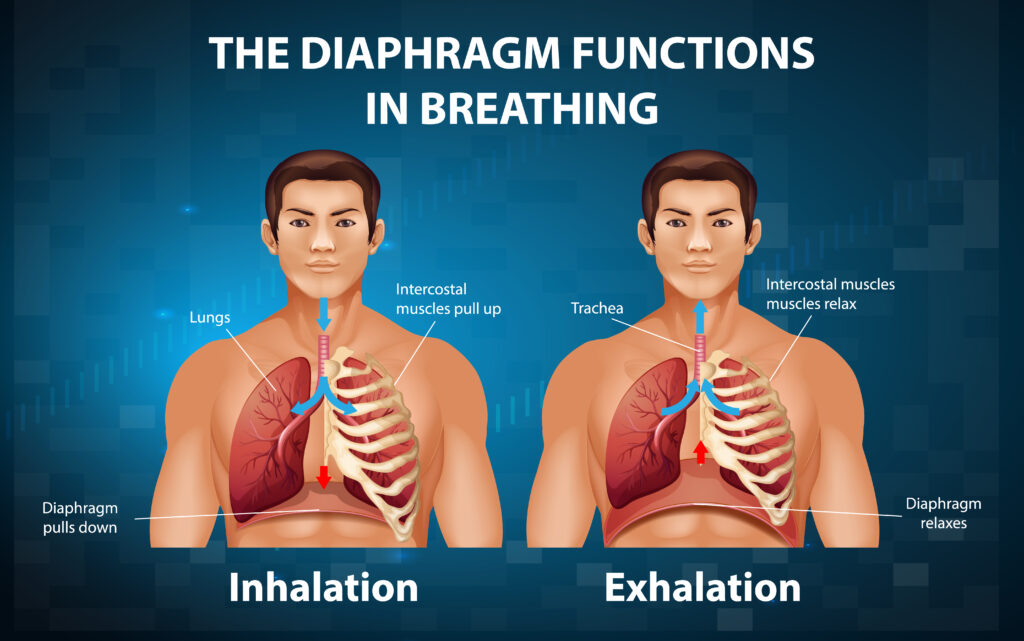Do you know which type of breathing is useful for your health while running? Don’t you? Aerobic respiration/breathing is beneficial while running. Why is Anaerobic respiration harmful for muscles? You know while running our heart rate increased by many folds due to lack of oxygen. Heart muscles and body muscles require more oxygen and energy to survive while running. In case of shortness of breath(anaerobic respiration) muscles receive less oxygen which causes accumulation of lactic acid in muscles which ultimately results in cramping of muscles, increased heart rate and shortness of breath. So, smooth breathing with excess oxygen is essential while running and more ATP produced through aerobic respiration.
Why Proper Breathing Matters for Runners
Proper breathing is the foremost requirement of runners. When you run, you and all your body muscles need an excess amount of energy because running is a hard physical job. Heart plays its role and demands more oxygen to respire aerobically to get more ATP s, it would fulfill the energy demand of body muscles. In this regard, oxygen supply is the most important thing for runners. Runners breathe more frequently and increase the energy supply so that their muscles may be protected from bad effects of lactic acid accumulation. To protect body muscles from cramping and to fulfill the energy demands of body muscles, breathing matters more for Runners.You will be surprised to know that running is the best way to evaluate your physical health status. Yes, it is. How? We will tell you. Look and be held at the breathing rate while you run. Running is a strenuous exercise. If you feel breathing difficulty during running it is an alarming sign for your physical health because smooth breathing during running ensures your heart, lungs and muscles health. Breathing difficulty during running causes harmful effects for your body.
The Basics of Breathing While Running
Nasal Breathing vs. Mouth Breathing: Main objective of breathing is to inhale oxygen and exhale carbon dioxide as a waste product. Breathing through nose is appreciated as compared to breathing through mouth because in nasal breathing the lungs receive pure air without dust particles while in mouth breathing all pollutants go to lungs through air. But it should be in your kind notice that breathing through the mouth is recommended while running for efficient supply of oxygen. Rate of oxygen supply is directly proportional to your muscles size and their efficiency. More you provide oxygen to your muscles, the more healthy life you will get.
Breathing Rhythm: Your gait is an important tool to make your breathing smooth while running. Make your breathing rhythmic. Produce a rhythm between your breathing and run. Rhythmic breathing is the best tool for runners to breathe smoothly. How can you implement this technique? Read out our article carefully, it will help you.
- Your respiratory muscles exert more effort while during your exercise when your breath rate is increased many folds. Diaphragm needs more energy but rhythmic breathing makes inhalation easier for your lungs and provide more to inhaled oxygen for a longer time to restore energy. It helps in smooth breathing while running.
- Rhythmic breathing actually refers to belly breathing with equal intervals of breath and run. 1 step with inhale and 1 step with exhale will help you in efficient breathing without causing muscle fatigue.
Tips for Effective Running Breathing
Running is a marvelous muscle exercise but one surprising fact by which most the people aren’t familiar is that running might be hazardous and injurious to health if it does not do properly. Yes, it is obvious, if you do not pay attention to your posture, position of head and spine while running, you may suffer from some serious physical disorders. Before starting running, some muscle stretching exercises are essential to avoid fatigue issues. Here are some healthy tips for you to breathe easily and efficiently for safe running practice.
Tip 1: Diaphragmatic Breathing: Using your diaphragm correctly for breathing can help you in breathing smoothly while running. Diaphragm is located in the chest cavity, a dome shaped muscle protected by a rib cage. This structure helps in the inhaling and exhaling process. Diaphragmatic breathing technique helps you to get your muscles to relax and get more efficient oxygen by decreasing heart rate and blood pressure.
Using your diaphragm correctly for breathing can help you in breathing smoothly while running. Diaphragm is located in the chest cavity, a dome shaped muscle protected by a rib cage. This structure helps in the inhaling and exhaling process. Diaphragmatic breathing technique helps you to get your muscles to relax and get more efficient oxygen by decreasing heart rate and blood pressure.
Tip 2: Breathing Cadence and Stride: Number of steps a runner takes in one minute, decides the run rate of a runner. Breath in one minute in accordance with the number of steps is well known as cadence. These two techniques must be followed by you if you want to relax during running. If you have Lon pace to run you should implement a 2:1 formula cadence to avoid side stitches. The shorter your stride the run rate will be faster and non tiring. 2 steps for inhaling and 1 step for exhaling is the best cadence rate.
Tip 3: Pursed-Lip Breathing: 
Running is an energy consuming and tiring physical activity. You need more ATP to continue running. Pursed lip breathing is helpful for you to lower the breathing pressure while running. During running your lungs may feel pressure due to shortness of breath. This problem may be overcome by using pursed lip breathing.
Tip 4: Belly Breathing: During running your nervous system gets tired and this may be dangerous but belly breathing is the best tool to overcome this obstacle. You just breathe in through your nose by closing your mouth. Fill your belly with air as you can. Now exhale the air slowly through pursed lips and nose this practice will feel you relax and is best for your heart rate and nerves.
During running your nervous system gets tired and this may be dangerous but belly breathing is the best tool to overcome this obstacle. You just breathe in through your nose by closing your mouth. Fill your belly with air as you can. Now exhale the air slowly through pursed lips and nose this practice will feel you relax and is best for your heart rate and nerves.
Breathing Techniques for Different Running Conditions
Here are some tips for you to provide you help in safe running in severe weather or other conditions.
Tip 5: Uphill and Downhill Running: While running uphill take some things in your notice. Like, look ahead but slightly lean your body without exerting force on the hip bone. Coincide your leg speed with your arm speed because while running uphill your arm speed decides your legs speed. Keep your stride shorter. Keep your momentum in balance by pushing on and going forward quickly. It will restore your energy.
Tip 6: Running in Hot and Humid Weather: Running in severe conditions like in hot and humid weather, will harm you in many ways. So some precautionary measures must be taken to avoid any unpleasant incident like heat stroke etc. overheating may be caused in high humid weather. Humidity slows the sweating and locked heat in your brain and other body parts. It is dangerous. So, if you live in a humid or hot area most of the time then keep your running pace small and focus on your exertion not your speed. Run in shade and drink water after small intervals to avoid dehydration. Wear Light colored clothes to reflect sunlight.
Tip 7: Running in Cold Weather: Runners no doubt have to face many challenges in the form of changing weather conditions. Cold weather also has some negative features for you if you are a runner. In cold weather, a runner must be in warm clothes with covered head and feet. Wearing gloves and staying visible in foggy weather is also necessary practice for safe running. After a run, dry yourself to avoid cold diseases like flu or joint pain.
Tip 8: Breathing at Different Paces: Run rate directly affects your heart. Usually 10 to 12 breaths per minute during running are considered safe but at high speed you must keep it at 6 to 9 breaths per minute. This practice will slow your breath rate and keep your heart safe. Try to start with a jogging technique to keep you safe from muscle cramps.
How to Listen to Your Body Through Your Breath
Along with many other fundamental arts, listening to your body is also an art. You should learn how to listen to your body. But how? It is very simple. Your breath can easily tell you about your body’s health conditions. Yes, it’s true your body gives you information about different organs through your breath. Here are some techniques which would help you to discover your body through breathing.
Recognizing Signs of Overexertion: 
Hard jobs, extraordinary physical hard work and strenuous physical jobs are the reasons for overexertion. Due to overexertion, you may suffer from body pain, muscle pain, joint pain and different types of body aches. Overexertion also causes short breath or difficulty breathing. This sign will lead you to stress and your focus may be disturbed. So, try to maintain your workload and keep your breathing smooth to avoid these problems.
Adjusting Your Breathing for Performance: Collaborate your breathing with your performance. It’s so easy. Follow 5-step breathing techniques to keep your body relaxed while running. Inhale 3 steps and exhale 2 steps is the well practiced formula for easy breathing. Take some body stretching exercises to stretch your rib muscles and limb muscles. Sleep in proper posture and take care of your lungs. In this regard you may follow some other breathing techniques like sun breathing, moon breathing, flower breathing etc.
Avoiding Side Stitches: You as a runner should take these precautions to avoid side stitches while running;
- Before you run, avoid fatty and spicy food
- Don’t eat 2 hours before running
- Daily work out before running
- Avoid beverages
- Perform core strengthening exercises
- Focus only on your breathing
Breathing Exercises and Drills for Runners
Exercise 1: Breathing Rhythms: While running, you hit the ground with your feet and at the same time use your diaphragm to inhale air into the lungs. If these practices are in accordance with each other, you will get rhythmic breathing. Rhythmic breathing enhances your run rate and limits the cramping muscles.this will protect you from injuries and side stitches. To learn rhythmic breathing you have to follow the belly breathing techniques 2 step, 3-step or 5-step. These techniques lessen the pressure on diaphragm and change the foot at every inhalation.
Exercise 2: Breath Awareness: Take deep breaths, by inhaling and exhaling in a balanced ratio. Match your inhale and exhale for each stride. It will be any. Like 2-step or 3-step. But both will be the same i.e. 2-step inhale and 2-step exhale.focus just on your breathing. Your breathing will increase with your run rate and eventually lungs will be pressurized. Heart rate will increase to fulfill the oxygen demand. Overexertion may be felt by you. Such things you may notice which will make you aware about your breathing conditions while running.
Exercise 3: Progressive Breath Control: If you’re a beginner, 2-2 step technique is best for you. You can manage your breathing and running speed by this method. But for the fast runners, it is the matter of days to control breath to enhance running speed. You know, running is also a part of meditation. So,by increasing your focus you will get more control on breathing while running.
Incorporating Breathing Practice Into Your Running Routine
An athlete can better understand the challenge of smooth breathing under stress conditions while running. But what about a common man? What about you and me? It is obvious from research that you should incorporate breathing practices in your daily routine to achieve many benefits. Daily chores like office working stress, household working and also during meditation, you should focus on your breathing. It will involve you in breathing exercises in routine life then you may take a step towards running.
Setting Breathing Goals: First of all, set a goal for yourself to involve your brain in this activity. Like give a task to yourself to maintain your breathing while standing on a stage before thousands of people. Take a challenge to control your breath while going upstairs. These small activities can teach you how to control and progress your breathing rate.
Consistency in Practice: Be consistent. Consistency is the surety of your success. Make a proper plan to keep check on your posture and position during the day while performing different tasks. Then take a careful look on your breathing rate in fight and flight mode. Then notice your breathing while at rest. Make it your habit. This practice will attract your attention to improve your breathing rate and then starting running will be easier for you.
Tracking Progress: To excel yourself in any field, you have to check your progress by taking tests or completing different tasks. Similarly, to become a best runner, you should check your progress in breathing by taking small tests or achieving goals. Set a goal for you by limiting breathing rate and increasing running rate without any overexertion. Then try hard and practice more and more to achieve that goal.
Expert Insights on Running and Breathing

Tips from Professional Runners: Richard Murray, a professional Runner says,Breathing while running is a much much more complex topic. Breathing involves all muscles of the body and breathing is a great asset of running. Many people ignore little things while running and it proves a damage for them. Running must be a relaxing practice for you instead of tiring one.
Insights from Running Coaches: As a professional coach and training specialist, Eric Dannenberg suggests “ To optimize your technique with breathing and running, simply start by being aware of your breath.” “ As I start to control my breath, I actually start to control my mind,” he says.
Breathing and Performance Enhancement: Breathing is directly interlinked with your performance enhancement. Through breathing you take in oxygen which breaks carbon bonds of food and a big blow of energy released from those bonds. This energy is used by your body organs to perform their respective activities more efficiently. Proper smooth breathing, releases stress by balancing your heart rate and blood pressure.
Conclusion
Running is the best way to keep your mind and body healthy and fit but with all these benefits the breathing control is the best benefit of running. You can run and breathe in a set pattern to enhance your potential. Breathing while running is the best source of relieving stress and anxiety. It burns your negative thoughts and promotes a positive approach.
Focused breathing while running improves the supply of oxygen which is ultimately beneficial for your different body systems for better functioning. Include a natural rhythm to your breathing which will relax your muscles and protect you from fatigue and dizziness. In short, controlled breathing will lead you towards physical and mental peace.







